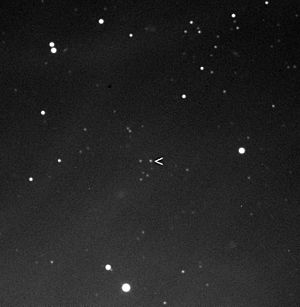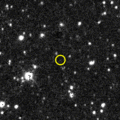Elara (moon) facts for kids

Elara near the glare of bright Jupiter
|
|
| Discovery | |
|---|---|
| Discovered by | C. D. Perrine |
| Discovery date | January 5, 1905 |
| Orbital characteristics | |
|
Mean orbit radius
|
11,740,000 km (0.07810 AU) |
| Eccentricity | 0.22 |
| 259.64 d (0.708 a) | |
|
Average orbital speed
|
3.27 km/s |
| Inclination | 26.63° (to the ecliptic) 30.66° (to Jupiter's equator) |
| Satellite of | Jupiter |
| Physical characteristics | |
|
Mean radius
|
43 km |
| ~23,200 km2 | |
| Volume | ~333,000 km3 |
| Mass | 8.7×1017 kg |
|
Mean density
|
2.6 g/cm3 (assumed) |
| ~0.031 m/s2 (0.003 g) | |
| ~0.052 km/s | |
|
Sidereal rotation period
|
~0.5 d (12 h) |
| Albedo | 0.04 (assumed) |
| Temperature | ~124 K |
| 16.3 | |
Elara is one of the many moons that orbit the giant planet Jupiter. It's not perfectly round like Earth's Moon; it has an irregular, non-spherical shape.
A scientist named Charles Dillon Perrine discovered Elara in 1905. He found it while working at the Lick Observatory. The moon is named after Elara, who in Greek myths was the mother of the giant Tityus by Zeus.
For a long time, Elara didn't have its current name. Until 1975, it was simply known as Jupiter VII. For a short time between 1955 and 1975, some people even called it "Hera".
Elara is part of a group of moons called the Himalia group. This group includes five moons that orbit Jupiter at a distance of about 11 million to 13 million kilometers. Their orbits are tilted at an angle of about 27.5 degrees. The way these moons orbit changes a lot because of the pull from the Sun and other planets.
Exploring Elara
In February and March of 2007, a spacecraft called New Horizons flew past Jupiter. This spacecraft was on its way to Pluto. As it passed by, New Horizons took many pictures of Elara. The closest photos were taken from about five million miles away.
Images for kids
See also
 In Spanish: Elara (satélite) para niños
In Spanish: Elara (satélite) para niños



